
Donald Trump’s Long Island Rally Draws Massive Crowd
On Wednesday, Donald Trump held a major campaign rally at Nassau Coliseum in Long Island, marking his second significant event in New York during this election cycle. The rally is part of his broader strategy to connect with New Yorkers, a traditionally Democratic-leaning electorate, as he seeks to sway voters in the 2024 presidential race. The event, held on the same day he was initially scheduled to be sentenced in his ongoing civil fraud trial, has sparked renewed attention on his campaign.
Massive Turnout and Support in Long Island
Trump’s campaign has been touting the Long Island event as a major milestone in terms of turnout and enthusiasm. The Nassau Coliseum, which holds up to 16,000 people, was filled to capacity, and the campaign claimed that over 60,000 tickets had been requested. This would make the Long Island rally one of the largest of Trump’s current campaign efforts, underscoring the loyalty and fervor of his supporters. Outside the venue, vendors set up booths selling Trump-themed merchandise, from flags and hats to golden cars adorned with Trump’s face.
Attendees began lining up hours before the event, eager to hear Trump speak and show their support. The crowd’s energy was palpable, with music blasting from speakers and many dressed in customized Trump apparel, further demonstrating the candidate’s strong base of support in the region.
Timing of the Rally: A Coincidence or Strategy?
The timing of this rally is particularly noteworthy, as it coincided with the day Trump was initially set to receive sentencing in his civil fraud trial. The sentencing was postponed until November 26, after the 2024 presidential election, potentially sparing Trump from immediate legal consequences during his campaign. The fraud trial is just one of many legal battles Trump is facing as he campaigns for the presidency, but it has not appeared to slow down his political efforts or diminish the support he receives from his base.
Trump’s Promise to Repeal the SALT Deduction Cap
A central theme of Trump’s speech was his promise to repeal the SALT deduction cap, which he introduced as part of the 2017 Tax Cuts and Jobs Act. The SALT (State and Local Taxes) deduction cap limits the amount of state and local taxes that taxpayers can deduct from their federal taxable income to $10,000. This policy disproportionately affects high-tax states like New York, where property taxes and state income taxes often exceed that limit.
During the rally, Trump declared, “I will get SALT back,” aiming to appeal to middle-class New Yorkers who have long opposed the cap. The issue has become a rallying cry for New York’s Republican lawmakers, who argue that it unfairly penalizes the state’s residents. However, Trump’s sudden reversal on a policy he once championed has raised eyebrows, particularly among fiscal conservatives who fear that repealing the SALT cap could significantly increase the federal deficit.
Reaching Out to New York’s Diverse Voters
Trump’s efforts to court New York voters go beyond appealing to fiscal concerns. In May, Trump held a rally in the South Bronx, a deeply Democratic area with a large Hispanic and Black population. This marked a clear attempt to broaden his appeal beyond his traditional base of white, rural voters. During that rally, Trump expressed confidence that even blue cities like New York could turn red. “We have levels of support that nobody’s seen before,” Trump told the crowd, highlighting his belief that minority voters are shifting toward the Republican Party.
By hosting rallies in the South Bronx and Long Island, Trump is signaling that he sees New York as a battleground, even though it has long been considered solidly Democratic. His campaign team hopes to energize Republican voters and potentially swing some down-ballot races in New York in favor of the GOP.
The Legal Cloud Looming Over Trump’s Campaign
While Trump’s rallies have drawn significant crowds and media attention, his ongoing legal troubles continue to cast a shadow over his campaign. In addition to the civil fraud trial, Trump is also facing a criminal trial related to hush money payments made during the 2016 election. Throughout his court appearances, Trump has sought to use the legal cases as rallying points, casting himself as a victim of political persecution.
Trump’s campaign has attempted to capitalize on these legal challenges, framing them as part of a broader effort by Democrats to undermine his candidacy. At the Long Island rally, Trump criticized New York prosecutors, accusing them of focusing on him instead of addressing issues like rising crime. “What the Democrats are doing to me, they could do to you,” Trump warned the crowd, reiterating his claims that the legal system is being weaponized against him.
Assassination Attempt Heightens Security Concerns
Another significant issue that has added urgency to Trump’s campaign is an apparent assassination attempt in West Palm Beach just days before the Long Island rally. The attempt, which took place while Trump was golfing, has led to heightened security around the former president and his events. Though no injuries were reported, the incident has intensified the sense of danger surrounding Trump’s campaign, further fueling the narrative that he is under siege by both political opponents and extremists.
Despite these challenges, Trump has pressed forward, using the assassination attempt as an example of the risks he is willing to take to serve the country. His campaign has also seized on the event to attack the Biden administration, accusing President Biden and Vice President Harris of fostering an environment of hostility toward Trump and his supporters.
Trump’s Strategy for New York: Is It Working?
As Trump continues to campaign in New York, the question remains: can he win over enough voters to make a real impact in a state that has consistently voted Democratic for decades? Polling data suggests that while Trump enjoys a loyal base of support in the state, flipping New York in a general election remains an uphill battle. However, the Trump campaign appears to be focusing less on winning the state outright and more on energizing the Republican base, particularly in suburban areas like Long Island.
By hosting rallies in both the Bronx and Long Island, Trump is attempting to appeal to a broad spectrum of voters, from working-class minorities in urban areas to wealthier, suburban voters who may be frustrated with New York’s high taxes. His promise to repeal the SALT deduction cap is clearly aimed at the latter group, while his outreach to minority communities signals an effort to broaden the GOP’s appeal.
Can Trump’s Message Resonate?
Trump’s message in New York has focused heavily on economic issues, particularly taxes and the SALT deduction cap, but he has also touched on themes of crime and public safety. By visiting a bodega in Harlem earlier this year that was the site of a fatal stabbing, Trump aimed to highlight what he sees as the failures of Democratic leadership to keep communities safe. He has also courted support from union workers, visiting a construction site in Manhattan to emphasize his commitment to blue-collar Americans.
In addition to his tax proposals, Trump has promised to address concerns about public safety in New York City. His campaign has criticized Democratic prosecutors for focusing on his legal cases while ignoring rising crime rates. Whether these messages resonate with New York voters remains to be seen, but Trump’s strategy appears to be aimed at creating a coalition of suburban and working-class voters who are frustrated with Democratic policies.
Conclusion: A Long Road Ahead
While New York may not be a battleground state in the traditional sense, Trump’s continued efforts to campaign there highlight his belief that he can make inroads, either by flipping voters or by pulling enthusiasm away from Democrats. With legal challenges mounting and the presidential election fast approaching, Trump’s strategy of appealing to both suburban and urban voters in New York will be critical to watch as the campaign progresses.
Whether his promises, particularly on issues like the SALT deduction cap, will be enough to sway voters remains unclear. However, the enthusiasm at his Long Island rally suggests that Trump’s base in New York remains strong, and his campaign is committed to trying to expand that base even further.




